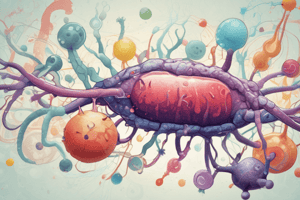Podcast
Questions and Answers
What is a method of writing a summary of the changes that occur in a chemical reaction?
What is a method of writing a summary of the changes that occur in a chemical reaction?
A chemical equation
What is the collective term for all of the chemical reactions in a living organism?
What is the collective term for all of the chemical reactions in a living organism?
Metabolism
What is involved in a chemical reaction?
What is involved in a chemical reaction?
Formation of chemical bonds, breaking of chemical bonds
What are present prior to the start of a chemical reaction?
What are present prior to the start of a chemical reaction?
Name the type of equation represented as A + B —> AB.
Name the type of equation represented as A + B —> AB.
Chemical reactions can be classified based on changes in a chemical __________.
Chemical reactions can be classified based on changes in a chemical __________.
Which type of reaction results when a large molecule breaks down into smaller molecules?
Which type of reaction results when a large molecule breaks down into smaller molecules?
A ____________ _____________ occurs when chemical bonds in a molecule are broken and new ones formed to produce a different structure.
A ____________ _____________ occurs when chemical bonds in a molecule are broken and new ones formed to produce a different structure.
What are these formed during a chemical reaction?
What are these formed during a chemical reaction?
What is the criteria for classifying a chemical reaction?
What is the criteria for classifying a chemical reaction?
Place the steps in enzyme action in proper order: 1 substrate binds to active site, 2 ________ in enzyme structure leads to induced fit, 3 ________ in enzyme structure stresses bonds in the substrate, 4 ________ bonds are broken, 5 ________ bonds are formed, 6 ________ is released from the enzyme.
Place the steps in enzyme action in proper order: 1 substrate binds to active site, 2 ________ in enzyme structure leads to induced fit, 3 ________ in enzyme structure stresses bonds in the substrate, 4 ________ bonds are broken, 5 ________ bonds are formed, 6 ________ is released from the enzyme.
Which terms can be used to classify reactions based on the relative amounts of energy in reactants and products?
Which terms can be used to classify reactions based on the relative amounts of energy in reactants and products?
What does an oxidoreductase do?
What does an oxidoreductase do?
What does a transferase do?
What does a transferase do?
What does a hydrolase do?
What does a hydrolase do?
What does an isomerase do?
What does an isomerase do?
What does a ligase do?
What does a ligase do?
What does a lyase do?
What does a lyase do?
What are forms of radiant energy?
What are forms of radiant energy?
What encompasses all of the decomposition reactions in an organism taken together?
What encompasses all of the decomposition reactions in an organism taken together?
Which statement is true of an enzyme: It decreases activation energy, It increases reaction rate.
Which statement is true of an enzyme: It decreases activation energy, It increases reaction rate.
What are the four stages of glucose oxidation?
What are the four stages of glucose oxidation?
Flashcards are hidden until you start studying
Study Notes
Chemical Reactions
- A chemical equation summarizes the changes that occur in a chemical reaction.
- Metabolism encompasses all chemical reactions within a living organism.
- Chemical reactions involve the formation and breaking of chemical bonds.
- Reactants are the substances present before a reaction occurs.
- Synthesis is represented by the equation A + B → AB.
Classification of Reactions
- Reactions can be classified based on changes in chemical structure.
- Decomposition reactions occur when a large molecule breaks down into smaller ones.
- Chemical reactions are characterized by the breaking of existing bonds and the formation of new ones.
- Criteria for classifying reactions include changes in chemical energy, structure, and the ability to reverse.
Enzyme Action
- Enzyme action follows a specific sequence:
- Substrate binds to the enzyme's active site.
- Enzyme structure changes to fit the substrate (induced fit).
- Bonds in the substrate are stressed and broken.
- New bonds are formed, resulting in the product.
- The product is then released from the enzyme.
Energy in Reactions
- Reactions can be categorized based on energy:
- Exergonic reactions release energy.
- Endergonic reactions require energy input.
Enzyme Types
- Oxidoreductase enzymes transfer electrons between substances.
- Transferase enzymes transfer functional groups.
- Hydrolase enzymes split chemical bonds using water.
- Isomerase enzymes convert one isomer into another.
- Ligase enzymes bond two molecules together.
- Lyase enzymes split chemical bonds without the use of water.
Radiant Energy
- Forms of radiant energy include ultraviolet light, visible light, and radio waves.
Catabolism
- Catabolism refers to all decomposition reactions occurring in an organism.
Enzymes as Catalysts
- Enzymes act as catalysts, lowering activation energy and increasing reaction rates.
Glucose Oxidation Stages
- Glucose oxidation occurs in four stages:
- Glycolysis
- Intermediate stage
- Citric acid cycle
- Electron transport system
Studying That Suits You
Use AI to generate personalized quizzes and flashcards to suit your learning preferences.




